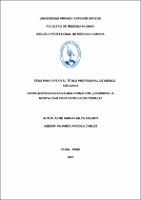Ventilación no invasiva más pronación: ¿disminuye la mortalidad en pacientes con COVID-19?

Ver/
Descargar
(application/pdf: 94.29Kb)
(application/pdf: 94.29Kb)
Fecha
2021Autor(es)
Hilya Solanyi, Ayme Narvay
Metadatos
Mostrar el registro completo del ítemResumen
INTRODUCCIÓN. El COVID-19 es una enfermedad que tiene manifestaciones
severas en algunos pacientes, los cuales necesitan soporte para mejorar sus
parámetros ventilatorios, optándose actualmente por estrategias de ventilación
no invasiva (VNI) y pronación para mejorar la oxigenación pulmonar.
OBJETIVO. El objetivo principal de esta investigación es revisar la literatura
sobre el uso de ventilación no invasiva más pronación en pacientes con COVID19 relacionado a disminución de la mortalidad disponible hasta julio del 2020
MÉTODOS. Se realizó un estudio de revisión narrativa, realizando una
búsqueda en PUBMED/Medline y SCOPUS, que permitió extraer los estudios
relevantes que fueron seleccionados para la esta revisión. RESULTADOS. Se
encontró que 20%-25% de pacientes con COVID-19 la VNI y la pronación
despierta pueden estabilizar su estado respiratorio y evitar la necesidad de
intubación. CONCLUSIONES: Debemos tener en cuenta que al usar
dispositivos asociados a VNI, se deben realizar en salas de presión negativa o
con filtros de acumulador de partículas de alta energía junto con el equipo de
protección adecuado. La posición de decúbito prono altera la mecánica y la
fisiología del intercambio de gases para dar como resultado una mejor
oxigenación. INTRODUCTION. COVID-19 is a disease that has severe manifestations in some
patients, who need support to improve their ventilatory parameters, currently opting for
non-invasive ventilation (NIV) and pronation strategies to improve lung oxygenation.
OBJECTIVE. The main objective of this research is to review the literature on the use
of non-invasive ventilation plus pronation in patients with COVID-19 related to a
decrease in mortality available until July 2020. METHODS. A narrative review study
was carried out, performing a search in PUBMED / Medline and SCOPUS, which
allowed us to extract the relevant studies that were selected for this review. RESULTS.
It was found that 20% -25% of COVID-19 patients, NIV and awake pronation can
stabilize their respiratory status and avoid the need for intubation. CONCLUSIONS.
We must bear in mind that when using devices associated with NIV, they must be
performed in negative pressure rooms or with high-energy particle accumulator filters
together with the appropriate protective equipment. The prone position alters the
mechanics and physiology of gas exchange to result in better oxygenation.
Palabras clave
Colecciones
- Medicina Humana [2969]

